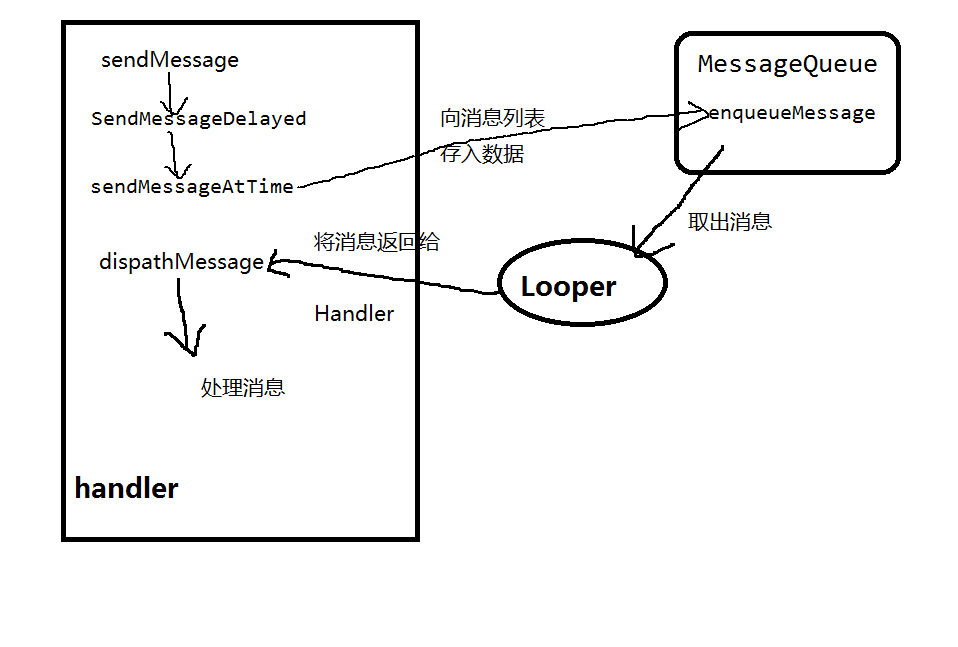Andrid的消息机制
消息机制概述
Android的消息机制主要是指Handler的运行机制以及Handler所附带的MessageQueue和Looper的工作过程。
Handler的主要作用是将一个任务切换到某个指定的线程中去执行。
Android规定访问UI只能在主线程中进行,如果在子线程中访问UI,程序就会排除异常。ViewRootImpl对UI操作做了验证,这个验证工作是由ViewRootImpl的checkThread方法来完成的。
void checkThread() {
if (mThread != Thread.currentThread()) {
throw new CalledFromWrongThreadException(
"Only the original thread that created a view hierarchy can touch its views.");
}
}Android系统不允许在子线程中访问UI?
这是因为Android的UI控件不是线程安全的,如果在多线程中并发访问可能会导致UI控件处于不可预期的状态。
为什么系统不对UI控件的访问加上锁机制呢?
1、加上锁机制会阻塞某些线程的执行
2、锁机制会降低UI访问的效率,因为锁机制会阻塞某些线程的执行。
鉴于这两个缺点,最简单高效的方法就是采用单线程模型来处理UI操作,这个时候我们只需要使用Handler切换UI访问的执行线程即可。
Android的消息机制分析
ThreadLocal的工作原理
ThreadLocal是一个线程内部的数据存储类,通过它可以在指定的线程中存储数据,存储数据以后,只有在指定线程中可以获取到存储的数据,对于其他线程来说则无法获取到数据。
我们来做一个例子:首先定义一个ThreadLocal对象,这里选择Boolean类型的。如下:
private ThreadLocal<Boolean> mBooleanThreadLocal=new ThreadLocal<>();然后分别再主线程、子线程1、子线程2中设置和访问它的值,代码如下:
mBooleanThreadLocal.set(true);
Log.e(TAG,"{Thread#main}mBooleanThreadLocal="+mBooleanThreadLocal.get());
/**thread1*/
new Thread(){
@Override
public void run() {
mBooleanThreadLocal.set(false);
Log.e(TAG,"{Thread#1}mBooleanThreadLocal="+mBooleanThreadLocal.get());
}
}.start();
/**thread2*/
new Thread(){
@Override
public void run() {
Log.e(TAG,"{Thread#2}mBooleanThreadLocal="+mBooleanThreadLocal.get());
}
}.start();我们来分析一下ThreadLocal的内部实现:
/**泛型类*/
public class ThreadLocal<T> {
/**get方法获取值*/
public T get() {
// Optimized for the fast path.
Thread currentThread = Thread.currentThread();
Values values = values(currentThread);
if (values != null) {
Object[] table = values.table;
int index = hash & values.mask;
if (this.reference == table[index]) {
return (T) table[index + 1];
}
} else {
values = initializeValues(currentThread);
}
return (T) values.getAfterMiss(this);
}
/**set方法设置值*/
public void set(T value) {
//获取当前运行的线程
Thread currentThread = Thread.currentThread();
Values values = values(currentThread);
if (values == null) {
values = initializeValues(currentThread);
}
values.put(this, value);
}
}从ThreadLocal的get和set方法中可以看到他们所操作的对象都是当前线程的localValues对象的table数组,因此在不同的线程中访问同一个ThreadLocal的set和get方法,他们对ThreadLocal所做的读/写操作仅限于个子线程的内部!所以ThreadLocal可以在多个线程中互不干扰的存储和修改数据。
消息队列的工作原理
消息队列在Android中指的是MessageQueue,MessageQueue包含两个操作:插入和读取。读取操作本身会伴随着删除操作。
插入的方法为:enqueueMessage,作用是往消息队列中插入一条消息。
读取的方法为:next,作用是从消息队列中读取出一条消息并将其从消息队列中移除。
MessageQueue内部实现是通过一个单链表的数据结构来维护消息列表,单链表在插入和删除上比较有优势。
MessageQueue的enqueueMessage方法:
boolean enqueueMessage(Message msg, long when) {
....
synchronized (this) {
....
msg.markInUse();
msg.when = when;
Message p = mMessages;
boolean needWake;
if (p == null || when == 0 || when < p.when) {
msg.next = p;
mMessages = msg;
needWake = mBlocked;
} else {
needWake = mBlocked && p.target == null && msg.isAsynchronous();
Message prev;
for (;;) {
prev = p;
p = p.next;
if (p == null || when < p.when) {
break;
}
if (needWake && p.isAsynchronous()) {
needWake = false;
}
}
msg.next = p; // invariant: p == prev.next
prev.next = msg;
}
if (needWake) {
nativeWake(mPtr);
}
}
return true;
}MessageQueue的next方法:
Message next() {
final long ptr = mPtr;
if (ptr == 0) {
return null;
}
int pendingIdleHandlerCount = -1; // -1 only during first iteration
int nextPollTimeoutMillis = 0;
for (;;) {
if (nextPollTimeoutMillis != 0) {
Binder.flushPendingCommands();
}
nativePollOnce(ptr, nextPollTimeoutMillis);
synchronized (this) {
// Try to retrieve the next message. Return if found.
final long now = SystemClock.uptimeMillis();
Message prevMsg = null;
Message msg = mMessages;
if (msg != null && msg.target == null) {
// Stalled by a barrier. Find the next asynchronous message in the queue.
do {
prevMsg = msg;
msg = msg.next;
} while (msg != null && !msg.isAsynchronous());
}
if (msg != null) {
if (now < msg.when) {
// Next message is not ready. Set a timeout to wake up when it is ready.
nextPollTimeoutMillis = (int) Math.min(msg.when - now, Integer.MAX_VALUE);
} else {
// Got a message.
mBlocked = false;
if (prevMsg != null) {
prevMsg.next = msg.next;
} else {
mMessages = msg.next;
}
msg.next = null;
if (DEBUG) Log.v(TAG, "Returning message: " + msg);
msg.markInUse();
return msg;
}
} else {
// No more messages.
nextPollTimeoutMillis = -1;
}
....
}
....
}
}我们发现next中有一个无线循环的方法,如果消息队列中没有消息,那么next方法会一直阻塞在这里,当有新消息到来时,next方法会返回这条消息并将其从单链表中删除。
Looper的工作原理
Looper在Android的消息机制中扮演着循环的角色,具体来说就是它会不停的从MessageQueue中查看是否有新消息,如果有新消息就会立即处理,否则就一直阻塞在哪里。
Looper的构造方法:
/**在构造方法中会创建一个MessageQueue消息队列*/
private Looper(boolean quitAllowed) {
mQueue = new MessageQueue(quitAllowed);
mThread = Thread.currentThread();
}通过Looper.prepare()为当前线程创建Looper对象,然后通过Looper.loop();开启消息循环。
new Thread(){
@Override
public void run() {
Looper.prepare();
Handler handler=new Handler();
Looper.loop();
}
}.start();Looper中还提供了一个prepareMainLooper方法,这个方法主要是给主线程也就是ActivityThread创建Looper使用的,其本质也是通过prepare方法来实现的。
同样Looper也是可以退出的:Looper提供了quit和quitSafely来退出一个Looper,他们的区别:
quit会直接退出Looper
quitSafely只是设定一个退出标记,然后把消息队列中的已有消息处理完毕后才安全退出。Looper退出后,通过Handler发送的消息会失败,这个时候Handler的send方法会返回false,同样在不需要Looper时,应该调用quit方法来终止消息循环,否则这个子线程会一直处于等待的状态。
Looper的loop方法:
public static void loop() {
final Looper me = myLooper();
if (me == null) {
throw new RuntimeException("No Looper; Looper.prepare() wasn't called on this thread.");
}
final MessageQueue queue = me.mQueue;
Binder.clearCallingIdentity();
final long ident = Binder.clearCallingIdentity();
/**这里一个死循环*/
for (;;) {
/**通过MessageQueue的next方法获取到消息*/
Message msg = queue.next(); // might block
if (msg == null) {
/**如果返回的消息是null,则跳出循环*/
return;
}
/**如果消息不为空,则进行消息的处理*/
msg.target.dispatchMessage(msg);
final long newIdent = Binder.clearCallingIdentity();
msg.recycleUnchecked();
}
}Handler的工作原理
Handler的工作主要包含消息的发送和接收过程,消息的发送可以通过post的一系列方法以及send的一系列方法来实现,post的一系列方法最终是通过send的一系列方法来实现的。
我们来看一下Handler的sendMessage方法:
/**调用了sendMessageDelayed方法*/
public final boolean sendMessage(Message msg){
return sendMessageDelayed(msg, 0);
}
/**这里又调用了sendMessageAtTime方法*/
public final boolean sendMessageDelayed(Message msg, long delayMillis){
if (delayMillis < 0) {
delayMillis = 0;
}
return sendMessageAtTime(msg, SystemClock.uptimeMillis() + delayMillis);
}
public boolean sendMessageAtTime(Message msg, long uptimeMillis) {
MessageQueue queue = mQueue;
//如果消息队列为空,则抛出异常
if (queue == null) {
RuntimeException e = new RuntimeException(
this + " sendMessageAtTime() called with no mQueue");
Log.w("Looper", e.getMessage(), e);
return false;
}
/**这里又调用了enqueueMessage方法*/
return enqueueMessage(queue, msg, uptimeMillis);
}
private boolean enqueueMessage(MessageQueue queue, Message msg, long uptimeMillis) {
msg.target = this;
if (mAsynchronous) {
msg.setAsynchronous(true);
}
/**这里调用了MessageQueue的enqueueMessage方法*/
return queue.enqueueMessage(msg, uptimeMillis);
}如图流程:
然后我们再来看处理消息:Looper对象将消息返回给Handler,Handler使用dispatchMessage去处理消息。
public void dispatchMessage(Message msg) {
//检查Messge的callback是否为null,不为null就通过handleCallback来处理消息
if (msg.callback != null) {
handleCallback(msg);
} else {
/**然后再这里判断CallBack是否为空,不为null就调用mCallback的handlerMessage来处理消息*/
if (mCallback != null) {
if (mCallback.handleMessage(msg)) {
return;
}
}
handleMessage(msg);
}
}这里呢:msg.callback()是一个Runnable对象。
private static void handleCallback(Message message) {
message.callback.run();
}mCallBack是一个接口:
public interface Callback {
public boolean handleMessage(Message msg);
}通过Callback 可以采用如下方式创建Handler对象:
Handler handler=new Handler(callback);
通过CallBack创建一个Handler的实例,并且不需要派生Handler的子类。
Handler还有一个特殊的构造方法,通过Looper来构造Handler来构造。当looper为空时,就会抛出异常。这也解释了在没有Looper的子线程中创建Handler会引发程序异常的原因。
public Handler(Looper looper){
this(looper,null,false);
}主线程的消息循环
Android的主线程就是ActivityThread,主线程的入口为main,在main方法中系统会通过Looper.prepareMainLooper()来创建主线程的Looper以及MessageQueue,并通过Looper.loop()俩开启主线程的消息循环。
public static void main(String[] args) {
....
Looper.prepareMainLooper();
ActivityThread thread = new ActivityThread();
thread.attach(false);
if (sMainThreadHandler == null) {
sMainThreadHandler = thread.getHandler();
}
Trace.traceEnd(Trace.TRACE_TAG_ACTIVITY_MANAGER);
Looper.loop();
throw new RuntimeException("Main thread loop unexpectedly exited");
} private class H extends Handler {
public static final int LAUNCH_ACTIVITY = 100;
public static final int PAUSE_ACTIVITY = 101;
public static final int PAUSE_ACTIVITY_FINISHING= 102;
public static final int STOP_ACTIVITY_SHOW = 103;
public static final int STOP_ACTIVITY_HIDE = 104;
public static final int SHOW_WINDOW = 105;
......
}ActivityThread通过Application和AMS进行进程间通讯,AMS以进程间通讯方式完成ActivityThread的请求后会回调ApplicationThread中的Binder方法,然后ApplicationThread会向H发消息,H收到消息后会将ApplicationThread中的逻辑切换到ACtivityThread中去执行,即切换到主线程中去执行,这个过程就是主线程的消息循环模型。
























 1万+
1万+

 被折叠的 条评论
为什么被折叠?
被折叠的 条评论
为什么被折叠?








